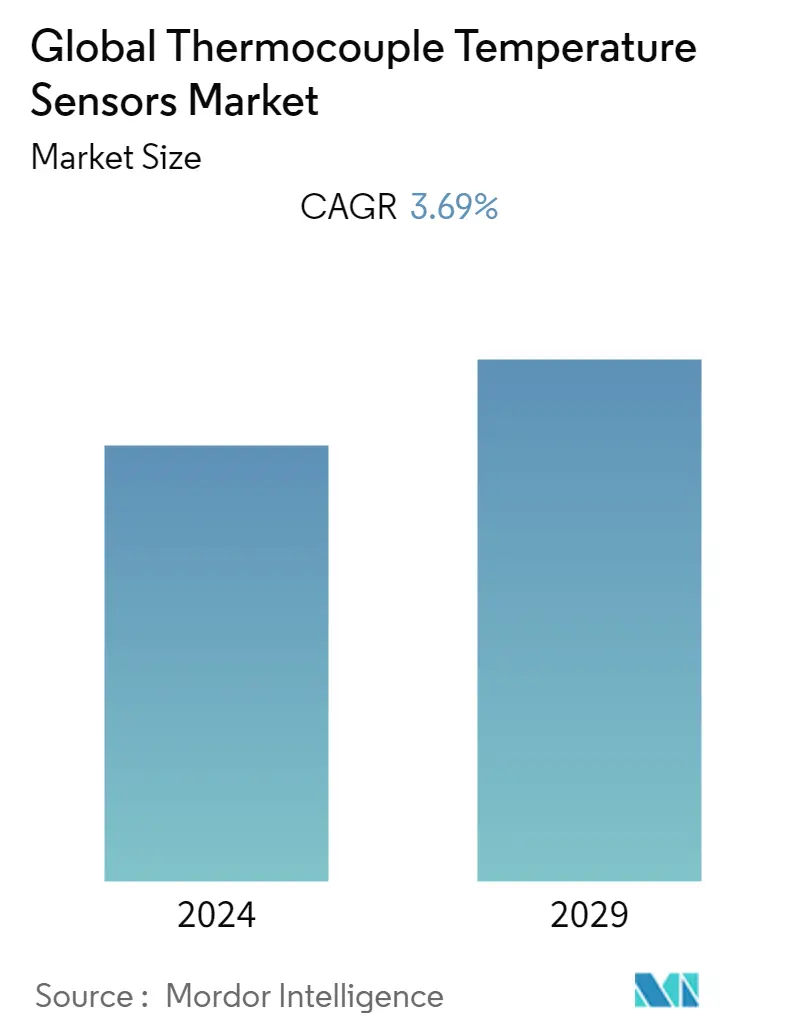Market Size of Global Thermocouple Temperature Sensors Industry

| Study Period | 2019 - 2029 |
| Base Year For Estimation | 2023 |
| CAGR | 3.69 % |
| Fastest Growing Market | Asia-Pacific |
| Largest Market | North America |
| Market Concentration | Medium |
Major Players.webp)
*Disclaimer: Major Players sorted in no particular order |
Thermocouple Temperature Sensors Market Analysis
The Thermocouple temperature sensors market was valued at USD 709.89 million in 2020 and is expected to reach USD 882.3 million by 2026 and grow at a CAGR of 3.68% over the forecast period (2021 - 2026). The increasingly popular trend of the development of smart cities in countries is contributing to the high growth of the electronic security market.
- Further, the introduction of advanced technologies in the global sensors market, along with the constantly growing trend of digital transformation in the industrial world, has resulted in the rising demand for sensors, especially for smart sensors.
- Thermocouple temperature sensors are mainly used for thermal management and automatic transmissions systems in the automotive industry. Therefore, the stringent emission norms for automobiles, aggressive development in autonomous vehicles, and increasing penetration of electric vehicles (EV), globally, are some of the major factors driving the market growth. For instance, the Indian government is focusing on creating charging infrastructure and policy framework, so that by 2030, more than 30% of vehicles are electric vehicles.
- STMicroelectronics' entered into a partnership with Hyundai Autron, to launch a development lab for eco-friendly automotive sensor solutions. The collaboration will provide the environment for engineers to collaborate on pioneering solutions for eco-friendly vehicles, with a focus on powertrain controllers.
- However, technical awareness about sensor and heating issues in the extreme condition is the key restraints which hamper the market growth.
Thermocouple Temperature Sensors Industry Segmentation
Thermocouple-based temperature sensors account for the largest share of the temperature sensors market. The main advantage of thermocouples is that they operate over a wide range of temperatures. In addition, they are among the few sensors that are strong enough to survive a high-temperature caustic environment, such as an engine.
| Geography | ||||||||
| ||||||||
| ||||||||
| ||||||||
| ||||||||
|
Global Thermocouple Temperature Sensors Market Size Summary
The thermocouple temperature sensors market is experiencing significant growth, driven by the increasing demand for smart sensors and the advancement of digital transformation in various industries. These sensors are crucial for thermal management and automatic transmission systems, particularly in the automotive sector, where stringent emission norms and the rise of electric and autonomous vehicles are key growth factors. The development of smart cities and the introduction of advanced technologies further bolster the market, as seen in collaborations like STMicroelectronics' partnership with Hyundai Autron to create eco-friendly automotive sensor solutions. However, challenges such as technical awareness regarding sensor performance in extreme conditions may hinder market expansion.
The market is poised for further growth due to the rising production of electric vehicles and the demand for temperature sensors in safety and precision measurements. The United States, with its robust automotive and aerospace industries, is expected to hold a significant market share, driven by the increasing adoption of electric vehicles and competitive aerospace manufacturing. Major players like Texas Instruments, STMicroelectronics, and Honeywell are actively engaging in strategic collaborations and acquisitions to enhance their market presence. Innovations such as Honeywell's smart thermostats and NXP's IoT prototyping kit highlight the ongoing technological advancements in the sector, which are likely to sustain the market's growth trajectory.
Global Thermocouple Temperature Sensors Market Size - Table of Contents
-
1. MARKET DYNAMICS
-
1.1 Introduction to Market Drivers and Restraints
-
1.2 Market Drivers
-
1.2.1 Rapid Technological Developments
-
1.2.2 Rising Trends of Security and Surveillance
-
-
1.3 Market Restraints
-
1.3.1 Dominance of Legacy Temperature Sensor Technologies
-
-
1.4 Value Chain / Supply Chain Analysis
-
1.5 Industry Attractiveness - Porter's Five Force Analysis
-
1.5.1 Threat of New Entrants
-
1.5.2 Bargaining Power of Buyers/Consumers
-
1.5.3 Bargaining Power of Suppliers
-
1.5.4 Threat of Substitute Products
-
1.5.5 Intensity of Competitive Rivalry
-
-
1.6 PESTLE Analysis
-
1.7
-
-
2. MARKET SEGMENTATION
-
2.1 Geography
-
2.1.1 North America
-
2.1.1.1 US
-
2.1.1.2 Canada
-
2.1.1.3 Mexico
-
2.1.1.4 Rest of North America
-
-
2.1.2 Europe
-
2.1.2.1 Germany
-
2.1.2.2 UK
-
2.1.2.3 France
-
2.1.2.4 Russia
-
2.1.2.5 Spain
-
2.1.2.6 Rest of Europe
-
-
2.1.3 Asia Pacific
-
2.1.3.1 China
-
2.1.3.2 Japan
-
2.1.3.3 India
-
2.1.3.4 South Korea
-
2.1.3.5 Rest of Asia-Pacific
-
-
2.1.4 South America
-
2.1.4.1 Brazil
-
2.1.4.2 Argentina
-
2.1.4.3 Rest of South America
-
-
2.1.5 Middle East and Africa
-
2.1.5.1 UAE
-
2.1.5.2 Saudi Arabia
-
2.1.5.3 South Africa
-
2.1.5.4 Egypt
-
2.1.5.5 Rest of Middle East and Africa
-
-
-
Global Thermocouple Temperature Sensors Market Size FAQs
What is the current Global Thermocouple Temperature Sensors Market size?
The Global Thermocouple Temperature Sensors Market is projected to register a CAGR of 3.69% during the forecast period (2024-2029)
Who are the key players in Global Thermocouple Temperature Sensors Market?
Honeywell, Danfoss, Texas Instruments, Maxim Integrated and NXP are the major companies operating in the Global Thermocouple Temperature Sensors Market.

